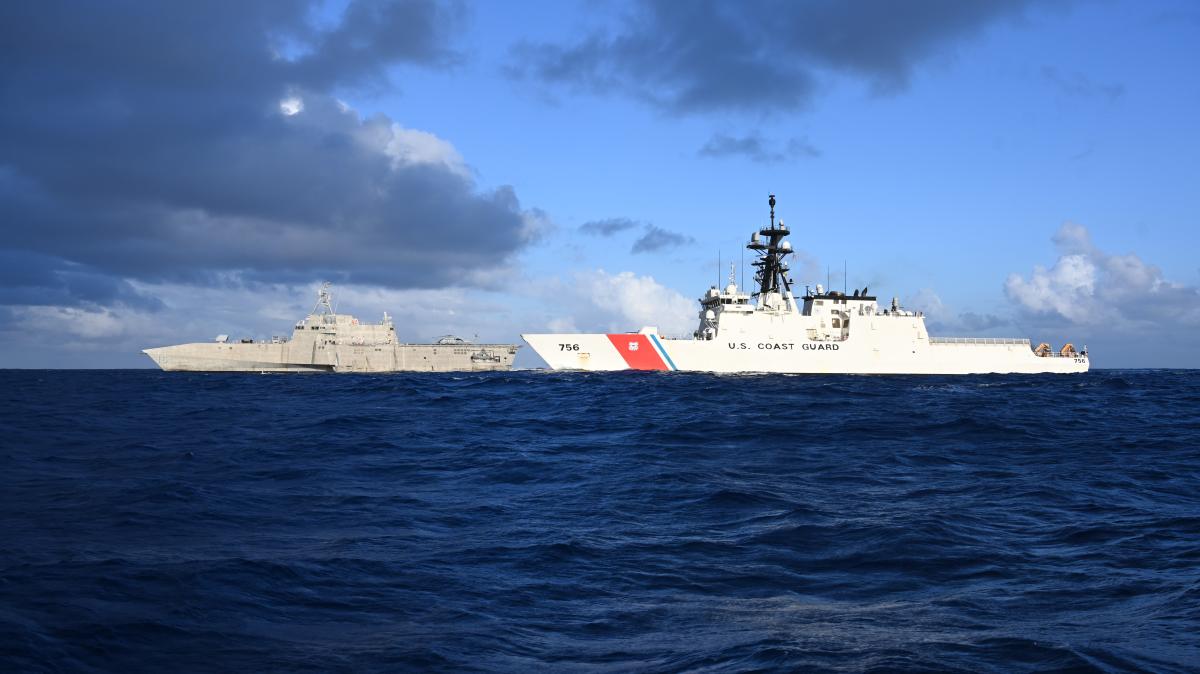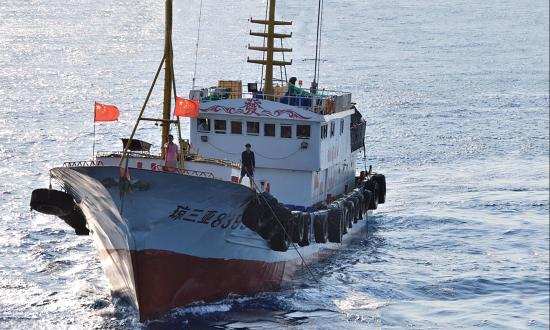On 12 February 1988, U.S. Navy and Soviet warships collided near the Crimean Peninsula in Soviet-claimed Black Sea waters not recognized by the United States. While the USS Yorktown (CG-48) and USS Caron (DD-970) maintained a freedom-of-navigation (FON) track, the Soviet commanders of the FFG-0811 Bezzavetnyi and the Mirka-class FFL-824 “bumped” the two warships. The U.S. warships transmitted messages capturing the day’s events:
From: USS Yorktown
To: Commander in Chief of United States Naval Forces in Europe
While conducting innocent passage south of the Crimean Peninsula, Yorktown was deliberately shouldered by Soviet Krivak I (FFG-0811) Bezzavetnyi. Minor damage sustained to hull, no holing or risk of flooding. Two Harpoon missiles on port fantail launcher are damaged and unusable. CasRep follows. Amplifying info to follow.
From: USS Caron
To: Commander in Chief of United States Naval Forces in Europe
IncSea [incident at sea] violation. Mirka-class FFL hull number 824 collided with Caron port side aft with no damage to ship or personnel at 0801Z. Prior to collision, Mirka passed to Caron on channel 16 VHF “Do not violate state borders of the Soviet Union, I am authorized to strike.”
In 1986, the same two U.S. Navy warships sailed along a similar FON track, with the Soviet Union denouncing the maneuvers as “defiant in nature and pursued clearly provocative aims.” Fleet Admiral V.N. Chernavin, Commander in Chief of the Soviet Navy, hinted that the Soviet Navy would have attacked if the U.S. warships remained in Soviet waters longer. Two years later, the Soviets escalated from saber rattling to ship ramming, but neither ship reported major damage and the incident produced no further escalation.
Today, rising tensions and bellicose rhetoric between the United States and China may lead to damaging collisions of U.S. Navy vessels during freedom of navigation operations (FONOPs), with the further potential for dangerous escalation. However, these risks can be mitigated by leveraging the US Coast Guard. The Coast Guard is materially suited and diplomatically well-poised to conduct routine FONOPs with its eight Legend-class national security cutters (NSCs) and planned 25 Heritage-class offshore patrol cutters (OPCs) to help ensure continued regional peace and stability.
What are FONOPs?
The United States has fought for the principle of free navigation on the world’s oceans for almost its entire history. British interference with the young United States’ maritime commerce was one of the catalyzing agents for the War of 1812. A century later, the sinking of U.S.-flagged merchant shipping helped pull the United States into the First World War. Just before being thrust into the Second World War, President Franklin Roosevelt declared that the United States armed forces had a “duty of maintaining the American policy of freedom of the seas.” President Ronald Reagan reaffirmed that commitment in the United States Oceans Policy Statement, declaring that: “The United States will exercise and assert its navigation and overflight rights and freedoms on a worldwide basis.”
FONOPs transcend partisan politics. President Barack Obama reiterated the United States’ commitment to freedom of the seas; President Donald Trump stepped up FONOPs in the South China Sea, and President Joe Biden appears to be following suit, with the first FONOPs conducted only 16 days after his inauguration day.
President Jimmy Carter’s administration formalized and established the Freedom of Navigation Program in 1979. Since then, the program has provided a persistent tool in countering excessive maritime claims that violate customary international law, as expressed by the United Nations Conventions for the Law of the Sea (UNCLOS). The program employs a two-pronged approach: The State Department first challenges excessive maritime claims through diplomatic protests. If the diplomatic protests fail to resolve the dispute, the Department of Defense serves as the second prong in challenging excessive maritime claims by flying, sailing, and operating wherever international law allows. The program includes FON assertions, with the primary intent to challenge excessive maritime claims, as well as FON-related activities that primarily support another operational purpose, but have a secondary intent of challenging excessive maritime claims. For operational security, many FON assertions and FON-related activities are only reported in the aggregate, with “general geographic information on the location of operational challenges.”
Although the United States is not a ratifying member of UNCLOS, it recognizes all but the section on undersea mining as reflecting customary international law—and uses the Freedom of Navigation Program to preserve this legal norm. As the title of a report from the Center for New American Security made clear, FONOPs are nothing new for the United States—they are “Business as Usual.”
Rising Tensions
Starting in 2015, the United States has notably focused its FONOPs on the South China Sea to contest the excessive Chinese claims in the Spratly and Paracel Islands. Commentators called for an expanded Coast Guard presence in the region and Coast Guard leadership mused publicly about “[creating] a permanent USCG presence in the South China Sea and related areas,” and how the service could “spearhead work with allies on freedom of navigation exercises.” Even so, most FONOPs have been and continue to be conducted by the Navy’s large surface combatants. China has met these operations on the high seas with strident rhetoric and a series of close encounters.
In 2018, a Chinese Luyang-class destroyer came within 45 yards of the USS Decatur (DDG-73) while the ship conducted FONOPs next to Gavin Reef, located in the Spratly Island chain. A spokesman for China’s Ministry of National Defense claimed the incident “threatened China’s sovereignty and security, seriously damaged the relations between the two countries and militaries, and endangered regional peace and stability.” Another FONOP conducted 1 June 2020 near the Paracel Islands by the USS Barry (DDG-52) elicited a similarly shrill denunciation.
More recent, in May of 2021, the USS Curtis Wilbur (DDG-54) conducted a FONOP by the Paracel Islands. The People’s Liberation Army (PLA) Southern Theatre Command spokesman decried the FONOP to have “seriously damaged peace and stability in the South China Sea” and that the “[FONOP] increases regional security risks, and is prone to misunderstandings, misjudgments and accidents at sea.”
Just four months later, a FONOP conducted by the USS Benfold (DDG-65) by the Spratly Islands in September was likewise met with a denunciation from the PLA Southern Theater Command, with the command spokesman claiming to have leveraged the PLA’s “air and naval forces to track, monitor and expel the vessel.” In the same statement, the spokesman also reaffirmed the PLA’s commitment to Chinese Communist Party’s perceived sovereign maritime claims and continued that “…troops in the theatre are always on high alert, and will resolutely defend national sovereignty...” Like the warships in the opening vignette, neither U.S. FONOPs policy nor Chinese maritime claims are changing course. If they collide, who would prevail?
Maintenance Woes
Rear Admiral Eric Ver Hage, the Commander of Navy Regional Maintenance Center and Director of Surface Ship Maintenance and Modernization, declared, “we don’t have enough ship repair) capacity for peacetime,” let alone to repair combat-damaged ships during wartime. Since August 2020, the USS John S. McCain (DDG-56) has conducted five FONOPs in a row, a departure from the historic, rotational norm that invites speculation on fleet sustainability.
The Navy has rightfully used littoral combat ships (LCSs) to conduct limited FONOPs in the South China Sea, somewhat relieving overworked destroyers like the USS John S. McCain. However, the smaller LCS’s myriad of problems, curtailed acquisition numbers, and early retirement of the first four hulls mean the Navy will soon have to lean even more heavily on larger and generally older ships. With only 10 to 14 cruisers and destroyers available to Seventh Fleet at any given time, the Navy can ill-afford to use these high-demand, low-density, Aegis ships for FONOPs. Although the Coast Guard is also stretched for resources because of its small size and robust missions and capabilities, leveraging both white and gray fleets expand the resources available for FONOPs.
Not Enough Firepower
Beyond maintenance woes, the Navy is facing an increasing firepower gap. Today’s fleet combat power is not measured in the caliber of large guns, but in the number of missiles a vessel can carry, as quantified by the number of vertical launch system (VLS) cells. However, current shipbuilding and retirement plans will leave the Navy with as many as 2,000 fewer VLS cells over the next few decades, just as China expands its fleet. The People’s Liberation Army Navy (PLAN) now fields 20 ships with combat systems comparable to modern U.S. guided-missile cruisers and destroyers, and will likely double that number by 2025. The Navy faces a growing “VLS gap” with the PLAN—to say nothing of China’s land-based missiles—but still assigns scarce VLS platforms such as DDGs and CGs to conduct FONOPs around the world. The United States can better preserve these potent assets by increasingly tasking Coast Guard vessels to conduct FONOPs in their stead.
The Coast Guard Solution
Just as the Soviets escalated from saber rattling to ramming in the 1988 Black Sea bumping incident, Chinese and U.S. Navy ships could soon collide over China’s excessive and illegal maritime claims. However, the Coast Guard could assist with or even become the preeminent service to conduct maritime FONOPs. Since 2019, the Coast Guard has sent cutters through the Taiwan Strait as part of the Pentagon’s FON program. In recognition of the service’s unique capabilities, the Coast Guard is also considering conducting FONOPs in the Arctic – and rightly so.
The Coast Guard is well positioned to ease potential escalations in FONOPs, reducing the risk of such a collision. By nature, Coast Guard NSCs and OPCs are far less intimidating—not to mention less expensive—than the destroyers and cruisers frequently used for FONOPs. Their white hulls represent the rule and order of maritime law while their instantly recognizable “racing stripe” has proved a deescalating factor in high-tension maritime missions throughout history and around the world—in short, they carry a lot of “street cred.” In the 2008 war between Russia and Georgia, the U.S. Coast Guard helped ease tensions while accomplishing the mission by delivering aid to Georgia.
The proliferation of the Chinese Coast Guard and maritime military militia has muddied the waters of the South China Sea into a gray zone. Their murky command structure and aggressive behavior collectively deter would-be challengers but also invite miscalculation, particularly in challenging a U.S. Navy FONOP. The Coast Guard is already heavily engaged with U.S. allies and partners in the western Pacific, and works with partner nations around the world in corralling the Chinese distant water fishing fleet engaged in illegal, unreported, and unregulated (IUU) fishing. This level of transparency and trust makes the service an obvious choice for routine FONOPs. Through their nature, partnerships, and experience, the Coast Guard can deter maritime escalation while conducting FONOPs, and so encourage cooler heads to prevail.
No ship conducting a FONOP is invulnerable, however, and critics argue that Coast Guard vessels may be too vulnerable during a FONOP, while others argue that the Coast Guard should not be part of maritime competition at all. But if a ship from the Chinese Navy, Coast Guard, or maritime militia were to ram a U.S. vessel conducting a FONOP, the ensuing visuals, narratives, and potential loss of combat capability would be starkly different between a Navy gray hull and a Coast Guard white hull. For a variety of diplomatic, informational, and tactical reasons, the United States would be better served having Coast Guard NSCs and OPCs conducting FONOPs and, if necessary, trading paint with a Chinese vessel.
NSCs and OPCs
NSCs and OPCs are ideal vessels to take over FONOPs. At nearly 4,500 tons, they are 1,000 tons heavier than the relatively fragile, aluminum-hulled LCSs. Both NSCs and OPCs are equipped with 57-mm deck guns, electronic warfare suites, and other defensive systems that provide basic survivability. Commandant of the Coast Guard Admiral Karl L. Shultz pointed out that “They’re not ballistic missile shooters, but not every place you need a ship or warship needs to have that BMD capability.” NSCs and OPCs performing FONOPs epitomize this statement.
More peacetime Coast Guard FONOPs—with and without Navy escorts—would help the fleet with sustainability issues and enable distributed maritime operations while simultaneously challenging excessive maritime claims. Using NSCs and OPCs will allow for more frequent FONOPs and further normalize sustained Coast Guard operations in the Western Pacific.
The 1988 Black Sea bumping incident provides many lessons. As the Navy shifts to enable distributed maritime operations, it can ill-afford to use high-demand, low-density assets for routine FONOPs. The loss of a large surface combatant while performing FONOPs in the Pacific is too grave in peacetime, let alone in the leadup to war. Admiral Shultz recently asked, “How do you think about the nation’s maritime capability through the broadest of lenses, and how [do those] Marine–Coast Guard–Navy pieces fit together?” One of the answers is the routine use of Coast Guard assets for FONOPs.






